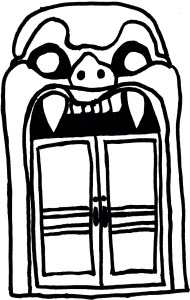When we were talking about coverage and discussing the Barbenheimer phenomenon, Brandon generously offered me the opportunity to be the one who covered Barbie, after I declared in no uncertain terms that I had no interest in Oppenheimer (sorry, Cillian). I did my part, going to the movie on opening night, wearing the only garment I own with any pink in it—a mostly-blue luau shirt with flamingos nestled in the pattern—and having my picture taken in the doll box that was being hastily assembled in the lobby when I arrived. It’s looking like this one will end up being a favorite for a lot of the Swampflix crew, and I’m happy to report that I had a good time as well.
Barbie (Margot Robbie) is the most popular resident of Barbieland, a pink utopia inhabited by a seemingly endless series of Barbies, including President Barbie (Issa Rae), Doctor Barbie (Hari Neff), Physicist Barbie (Emma Mackey), Journalist Barbie (Ritu Arya), and Author Barbie (Alexandra Schipp). There are also a multitude of Kens, including the “stereotypical” Ken (Ryan Gosling), whose job is “beach” and who is paired with likewise stereotypical Prime!Barbie. Also present is his primary rival Ken (Simu Liu), and several others (including Ncuti Gatwa), as well as one-offs like Ken’s friend Allan (Michael Cera) and poor pregnant Midge (Emerald Fennell). Every day is beautiful, as Barbie interacts with her dreamhouse, drinking imaginary milk from empty doll cups and bathing in a waterless shower, then goes about her adventures before retiring back to her home for a nightly dance party. Things couldn’t be more perfect, until one day Prime!Barbie asks the others if they ever think about dying, which brings the party to a screeching halt. The next day, nothing goes right; her shower is inexplicably cold, her imaginary milk is spoiled, her heart shaped waffles are burned and fail to land perfectly on her plate, and worst of all, she’s somehow become a flat-footed doll in a world of high heels. At the advice of her compatriots, she seeks guidance about her situation from “Weird” Barbie (Kate McKinnon), who was “played with too hard.” Weird Barbie sends Prime!Barbie on a quest to the real world to find the girl who’s playing with her so that she can cheer her back up so that her distinctly un-Barbie thoughts stop finding their way into Prime!Barbie’s head.
In the real world, Gloria (America Ferrera) is the receptionist at Mattel, a company that, despite depending on the monetization of the fantasies of little girls, is run entirely by men in identical gray suits; she finds herself drawing concepts for new dolls that share/embody her personal ennui. When Barbie (with stowaway Ken) escapes the boundaries of Barbieland and enters California via a portal at Venice Beach, young Mattel employee Aaron (Connor Swindells, the third alum from Sex Education in the movie) is contacted by the FBI to warn the dollmakers about this breach, and he delivers the news directly to the CEO (Will Ferrell). Elsewhere, Barbie’s search for her doll seems to lead to a dead end as she finds Sasha (Ariana Greenblatt), her presumed dollplayer, only to find that the girl has become a tween edgelady who dresses down the cowboy-clad living doll for her ties to capitalism, neoliberal feminism, and body dysmorphia. While this is happening, Ken comes face-to-face with the omnipresent patriarchal nature of the real world, wholeheartedly buying into the ideals of male domination because of his own lack of fulfillment in his non-relationship with Barbie. Upon his return, he spreads this anti-gospel around to the other Kens, which leads to all of the Barbies losing the memories of their impressive accomplishments in lieu of becoming servile dolls to the Kens with whom they are paired. With help from Gloria and Sasha, who are mother and daughter, Prime!Barbie has to try and wrest control of Barbieland back before it becomes the Kendom forever.
Early marketing for the movie featured that famous image of Margot Robbie, currently poised at the moment between memetic and iconic, with the tagline “Barbie is everything.” And not only is she, but Robbie is a star, baby. Although there may never come a day when society forgives Suicide Squad, it’s time for us to all try and forget it, because Robbie is really outdoing herself with each new project. As an actress, her absolute control over her every movement and facial muscle is astonishing. When confronted by a world in which she is frequently hated instead of universally beloved, it would be easy for this sort of narrative turn to feel like one of those “the regent learns their subjects hate them” plots, but because Robbie’s Barbie is kind, empathetic, fun-loving, and heretofore carefree, it’s emotionally devastating, and Robbie makes it work. That having been said, the beating emotional heart at the center of the film is America Ferrera, whose Gloria is the motivating factor behind all of the events of the film, and who gives a powerhouse monologue near the film’s climax that utterly steals the show. Kate McKinnon’s smaller part is also a delight, and the explanations of how she came to be the way that she is have a kind of quintessence of truth that I couldn’t help but laugh at. I was a bit disappointed upon the initial entrance into the real world with Gosling’s Ken instead of Liu’s, the latter of whom I found much more charming in their initial scenes, but given that specific Ken is called on to temporarily become the king of the jerks, literally and figuratively, I came to prefer that it was Gosling’s Ken who becomes the film’s antagonist for a bit.
At the core of that antagonism is Ken’s deep and profound insecurity. Ken’s existence, his destiny, is to be “and Ken” to Prime!Barbie, secondary to her. Since Barbie—as the idealization of a certain idea of liberated womanhood—doesn’t need him the way that he needs her, he lives in a perpetual existential crisis in which he has no real job or purpose other than an exaggeratedly asymmetrical relationship. It’s precisely this lack of security in his identity that leaves him open to being brain-poisoned by patriarchy, and he even ultimately admits that he got carried away and that what he really wanted to get into wasn’t phallocentric government so much as horses (it makes sense in context … sort of). There was no way that a movie like this one wasn’t going to end up on the radar of all the expected grifter outrage manufacturing machine mouthpieces, but the ones who can’t stop blathering on and on about film’s “woke” agenda with the fury of a man who’s mad that his wife put the cookies on a shelf he can’t reach; they’re really tattling on themselves with this outing, even more than usual. It takes a truly deep level of self-doubt and an utter dearth of self-reflection to take a look at this movie, which is about how sad, unfulfilled men unsuccessfully try to fill that void inside with toxic masculinity and be like “This is a movie that attacks me personally.” Do you not even see how much you’re showing your whole ass with that, bro? The Kens aren’t even doing the things that are violent, just the things that are annoying, like keeping a slovenly house, favoring patent leather couches, and mansplaining The Godfather. They’re not trying to entrap women through emotionally manipulative therapy lingo, or being shitty to their pregnant wife while she begs to be allowed to leave the house without administering veterinary medicine that she’s medically forbidden to handle, or isolating a woman with the intent to do harm. Don’t be like that. Just have a “brewski-beer” and teach yourself how to play a Matchbox Twenty song or two and let this one float past you in the stream, man.
In this case, the MST3k mantra applies on a couple of levels. Remember, this is just a movie, and you should just relax, both in any attempts to make this light, effervescent, bubblegum movie into another wedge in the culture war, and in the more traditional sense of letting go of the urge to try to figure out the exact limits of the film’s internal logic. It’s not what anyone is here for. This is an aesthetic experience just as much as (if not more than) it is a narrative one, and that’s what art is, baby. Just have a good time.
-Mark “Boomer” Redmond





